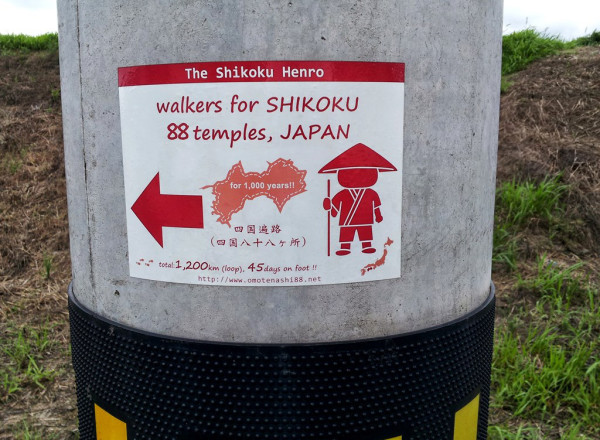If you spend some time on Shikoku, even if you don’t do the Shikoku Pilgrimage, you are likely to encounter tiny signs, usually white, with a small red Ohenro-san pilgrim on them. Their purpose is to help pilgrims find their way to the next temple, and indicate the henro trail.
A little while ago, I saw a quite surprising one.
Surprising for two reasons. First because it simply was a sticker on an electrical pole not too far from my house. However, even if I live almost halfway through Ichinomiya-ji and Yashima-ji, the actual pilgrimage route doesn’t really go through my neighborhood (now, when the “henro trail” goes through an urban area, there isn’t always just one route, even if there is always a historical/traditional one).
The other surprising thing about this sticker is that it’s mostly in English:
Why is that? No idea. Even if the number of foreign Shikoku Henro Pilgrims is getting larger and larger every year, it is still a very small number, and it is until now the only sign in English I have seen.
Of course, I went and checked out the web address that’s on it. It is the Network for Shikoku Henro Pilgrimage and Hospitality. I had never heard of this NPO before, but if you’re interested in the Shikoku Pilgrimage, I believe that it may be interesting for you.

I seem to recall a recent kerfuffle about anti-Korean posters?
I’m going to do this pilgrimage when I retire, and I’m going to walk the entire route. No cheating by bus. No group thing. Just Ru and the road.
The only place where I’ve heard about this anti-Korean thing was in the Japan Times… Just saying…
I think this is the plan for a lot of us, to do it the “traditional way”
That pilgrimage is something that I want to do in my lifetime but I don’t know if I can do it. It will be a month? Too long to be without a job. Who knows though. I’ll see what I can do. I’d have to start in Wakayama though…
Checking that website soon.
Make it two months. It’s feasible in one month is you walk fast… for the entire route.
Why start in Wakayama? Because of Koya-san?
Well, it’s not part of the pilgrimage. The pilgrimage starts at Ryozen-ji in Tokushima, and ends at Okuo-ji in Kagawa.
Afterwards, you’re technically supposed to go to Koya-san, but it doesn’t have to be right after, it can be months or even years after if I understood correctly.
I never really intended to walk it to be honest. I would rent a bike and do it that way, or cycle. I’m not too sure though.
The old tradition is to start and end at Koyasan.
https://en.wikipedia.org/wiki/Shikoku_Pilgrimage
Anyways, just a thought. Not really planning to do it anytime soon. Maybe I’ll wait until my next lifetime. 😉
I did the pilgrimage in 2010. I didn’t have enough time to walk, so I rode my bicycle. I’m an old guy, and it took me 24 days. Others have done it much faster than that. I started in Wakayama just because that’s where the ferry leaves for Tokushima. If you have time, tradition suggests that you should visit Koyasan both before and after the pilgrimage. Beforehand to request Kukai’s protection for the journey, and afterwards to report to him your successful completion and offer thanks. Because of time limitations, I went only after leaving Shikoku.
By the way, there is no requirement to do the entire pilgrimage in one trip. Many pilgrims walk only as much as they can in the time available to them, taking several years to complete the full circuit. Others have devoted their final years to walking the route continuously, and you will see them with dozens of temple stamps on each page of their book.
Hi Damian,
Thanks for stopping by and for your feedback. It’s always good to hear from people who have done the pilgrimage.
Yes, for the two months, I meant on foot. I know it’s not the only way to do it, but it’s the way that appeals to me (doing it on a bike seems more difficult in a sense, climbing all those hills and mountains on a bike… scary…)
I didn’t know about visiting Koya-san before starting. When you go to Ryozen-ji, it really feels like the beginning.
Concerning doing the pilgrimage in one trip or many and how to do it (on foot, bike, car, etc), it obviously depends on many factors, but personally, what I really find interesting as I’m not a religious person, is the experience of walking around Shikoku, I know it will be an amazing adventure, the temples are almost secondary in a sense.
My in-laws have done it several times (by car) in several trips, but as they’re old Japanese people, their approach of the thing is quite different from mine.
And in a sense I kinda have started to do it as I have been to 12 temples (in five years, and not in order). 🙂
But as I just said, what happens in between the temples when you walk the pilgrimage attracts me as much if not more than the temples.